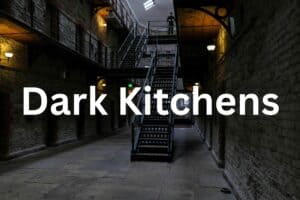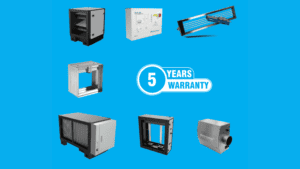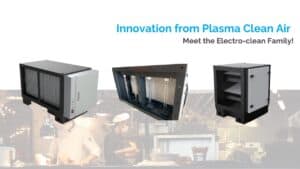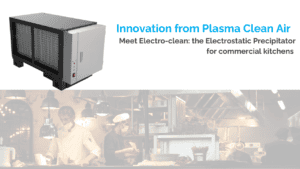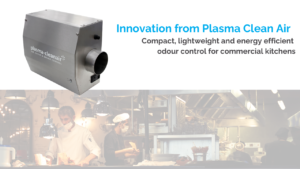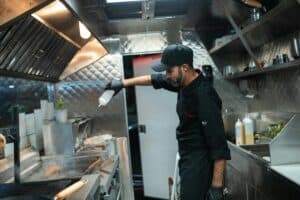From canopy to extraction point – what you need to know and do to keep your kitchen ventilation system compliant.
Did you know it is a legal requirement to complete a Building Fire Assessment? Do you know what aspects of your ventilation system need to be included within the Fire Risk Assessment?
Since the introduction of TR19® there has been a higher awareness of cleanliness in supply ventilation and kitchen extract ductwork. The new TR19® Grease specification for Fire Risk Management of Grease Accumulation within Kitchen Extraction Systems issued in July 2019 raises the standard for duct cleaning. Failure to comply with the new TR19® Grease specification means that you also fail to control fire risk.
Why clean your kitchen extract systems?
As per BESA TR19® Greasespecification and to comply with the Regulatory Reform Fire Safety Order 2005, grease extract systems must be inspected, tested and cleaned regularly to ensure mitigation of fire hazards.
Advice and guidance from the Health and Safety Executive (HSE), BRSIA and RISCAuthority stipulate that kitchen extract systems should be kept clean to minimise fire and health and safety risks.
More recently under the Fire Safety Act 2021, Article 50 of the Regulatory Reform (Fire Safety) Order 2005 (S.I. 2005/1541) (guidance) was amended and now ‘proof of a failure to comply with…or proof of compliance with any applicable risk based guidance’ may be relied on as proof of contravention of Articles 8 to 22 of these regulations.
Those responsible for their Building Fire Risk Assessment must therefore now know and provide evidence of compliance to the applicable risk- based guidance. This should include confirmation of location of fire dampers and their regular servicing, maintenance of fire suppression systems where present and regular cleaning of kitchen extraction systems to TR19® risk- based standards.
The risks
Should a kitchen extract ductwork fire occur, smoke and flames can be carried through the ductwork to cause damage throughout the building, putting lives in risk. Buildings insurance can also be compromised.
And as per the Fire Safety Act, contravention of these regulations could have legal consequences for the persons responsible for the Fire Risk Assessment.
Fire Dampers: What is required
Under the Regulatory Reform (Fire Safety) Order it is a legal requirement to test fire dampers at regular intervals in accordance with fire safety in the design, management and use of buildings code of practice (BS:9999 2017), using a method known as ‘drop testing’. Previously, under BS:9999 2008, fire dampers were categorised according to their type; a small number needed to be drop tested only every two years; now all fire dampers must be drop tested and cleaned annually.
In future, FMs will also be responsible for compliance with TR19®, the main guidance document for ventilation ductwork hygiene, issued by the Building & Engineering Services Association (BESA), as well as BS:9999.
You must document your drop testing and, where required, cleaning and maintenance, to demonstrate your compliance. As the person responsible for the property, you should be able to prove, in the event of a fire or a visit from a Fire Brigade fire safety compliance officer, that you have complied with the law. If you can’t do this, you could be prosecuted for negligence and, in the most serious of cases following a fire and failure of fire dampers, get a custodial sentence. We advise getting photographs of before the test, the closure of the drop test and the reopened damper after the test. It is good practice to have photographic evidence of compliance with TB/001, the guidance issued by BESA.
Fire Suppression: What is needed
Restaurants and commercial kitchens are uniquely at risk for fire due to high heat, grease, and open flame. For kitchens, it is best to have an automatic fire suppression system installed so little time is wasted when warning signs are detected. Wet chemicals are used in restaurant fire suppression systems and are the most rigorous fire extinguishing agents for the special needs of kitchens.
Fire suppression standards suggest a basic service every 12 months, in line with a regular Fire Risk Assessment (FRA).
Cleaning kitchen extract systems: what should you do
In kitchen ventilation, depending on the level of grease and smoke in the cooking process, the ductwork and grease control solutions require a cleaning regime.
Under TR19® Grease specification pre and post clean grease measurements (Grease Thickness Test) should be taken from representative locations such as the canopy extract plenum, 1m from each canopy, etc as detailed in Section 6 (TR19® Grease). These readings (where access has been possible) should be details in the post clean report
.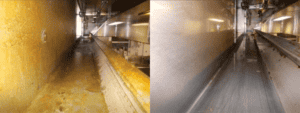
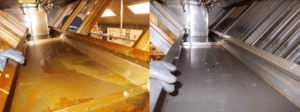
Your contractor should take measurements of grease deposition at these various points within the duct. An average of 200 microns thickness (about half the thickness of an average business card!) means the whole duct needs to be cleaned and any regions of 500 microns or more need spot (immediate) cleaning. The duct may not always be accessible, so duct cleaning isn’t always possible.
In instances where cleaning is not possible the contractor should detail on the report where this work has not been carried out and the reasons why as well as recommendations as to what would allow full cleaning – such as access doors, further modifications to the ductwork. Completing the recommended works would fall under the duty of the Fire Risk/Safety Officer.
What else do you need to know
TR19® and its predecessors have long since been recognised by the Building Services and UK Insurance industries as the standard to which ventilation systems should be cleaned to. To ensure conformance to these guidelines we recommend using a maintenance contractor that can supply certification and documentation of any works completed that would form part of your Fire Risk Assessment.
Fortis Services, part of the Plasma Clean group, can offer full fire risk assessment maintenance packages. We can identify and service fire dampers, maintain fire suppression systems and we can provide fully compliant TR19® Grease commercial kitchen extract cleaning with report.
